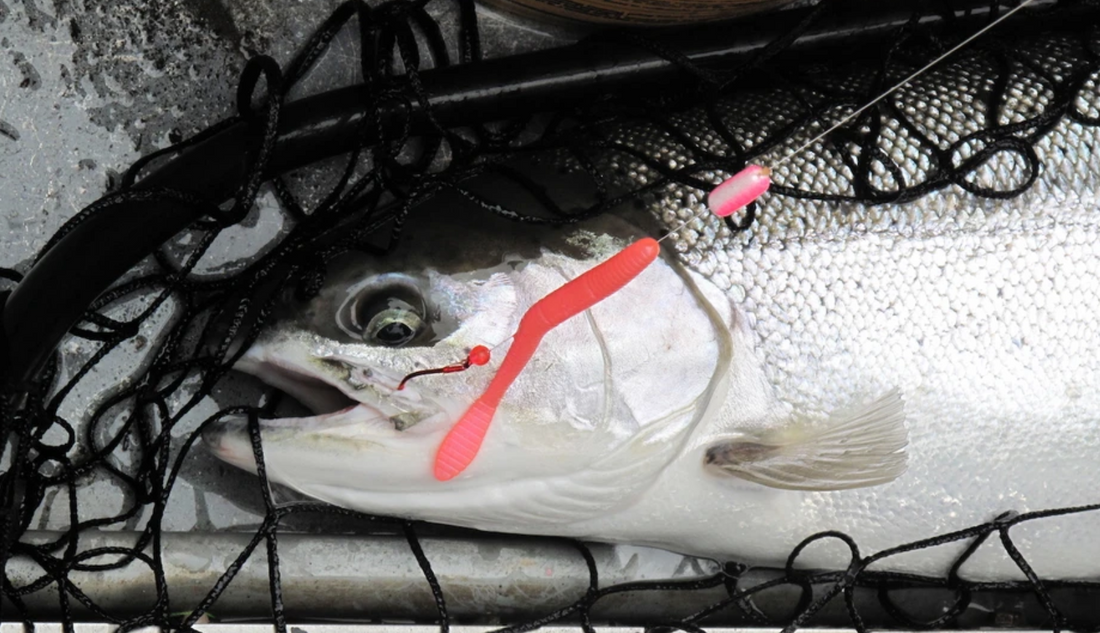A silver bullet of a steelhead plunged out of the water doing mid-air flips. Getting a good look at the fish my heart rate raced as this time it would be my first steelhead at the magical 20 pound mark.
The big hen finally conceded.
Grasping her tail and holding her in my hands I couldn’t believe how a fish could be so beautiful and so big. I eased the hook and pink worm rig out of her mouth while keeping water running through her gills. A few quick photos and I eased her back to the current seam she had been sitting in when she violently grabbed my offering.
When it comes to late season steelhead, a time known for the big native fish to arrive, I switch from using bait to strictly offering gear.
Admittedly I am not much of a hardware fisherman such as spoons and spinners.

The pink worm started as an abnormality in the steelhead fishing world.
Like most techniques it is rumored to have started in Canada and slowly migrated south. Much like Spey fishing is becoming the “rage” today drifting pink worms were the new “thing” in the 1990’s. I even admit the first time trying them was on a guided trip down an Olympic Peninsula river in late March and couldn’t believe a steelhead would bite it. But they do. In fact steelhead will attack the worms violently. There is no guessing when it comes to a bite. The whole idea of offering a 4- to 6-inch lure for a steelhead and it causing such a vicious bite goes against what I had learned about steelhead.
Being taught to downsize presentations, offer jigs in red and black, small baits such as egg clusters or sand shrimp tails. The nibble of a bite or the holding of the bait in their mouth causing a slight pause all called for long, limber, super sensitive rods. But rubber worm fishing allows the use of a stout backed rod, heavy lines and a way to play a heavy fish to the bank without causing it to exhaust itself to near death.
Another plus is not injuring native fish as the worm’s profile allows for the hook to catch the corner of the fish’s mouth. Unlike bait, rarely does a worm rig get swallowed by the fish. And if you don’t switch out the treble hooks from your spinners, spoon, and plugs to single siwash hook then mortality can be a serious problem with those techniques.
The worm set up is perfect for late season steelhead.
Being made of stretchable rubber allows you to fish it for several hours without the need to change it out which also makes them fairly inexpensive to fish as well.
Here’s how to rig and fish rubber worms. For starters a rod from 7 ½ to 9 ½ feet in length will work, with the longer rods making farther casts easier. The rod should be rated for 10- to 20-pound test line. I like to use spinning rods as this allows me to use lighter weights, but a fishing partner of mine likes to use a casting outfit, either one will work and is personal preference.
I started using braided line a few years ago and really like the 20-pound rated lines as they are 6-pound monofilament diameter. Use a snap swivel and tie the mainline onto the end of the swivel. Most prefer to use slinky weights, but pencil lead with a hole punch works good too. Snap the weight into the clasp of the snap swivel and tie the leader to the other end. I pre-tie my worm setups with 10 pound clear platinum mono from Izorline.
My fishing partner with the bait caster uses 20-pound test for leaders and catches a lot of fish. Use a bait threader to thread the line through a worm and then slide a bait float above it such as a Corkie, Cheater, or my favorite the Cha Cha pill float by Mack’s lure as their profile matches the worm and since they are made from a high dense poly foam they float high keeping the worm drifting along in the river. One helpful hint is to rub your favorite scent on the leader before you thread on the worm as it helps with running the leader through the rubber.
Popular sizes are worms in 4 to 6 inches but the smaller 2 ½- and 3-inch rubber worms work well on a jig head. If drift fishing the worms use hooks in sizes 1 to 1/0 depending on the length of the worm. Hook placement is debatable as some will fish the rig with the hook at the middle of the worm and some will run them with the hook almost at the tail. I prefer the latter with the hook about an inch from the end of the tail on both the 4- and 6-inch worms.
Rubber worms are buoyant and can take a while to get down to where the fish are. Use a weight that is fixed and not sliding on the mainline and leaders 18 to 24 inches. This allows your rig to get down into the fish immediately which is important because steelhead like to lay behind boulders, along cut banks or next to root wads.
You might only get one cast at a fish and if you toss it too far you’re likely to hang up on the structure the fish is using for cover. By being able to land your gear just in front of the holding water and getting it down fast to the fish you are more likely to cause a violent bite.
Steelhead like water with boulders for cover and will use sunken logs and other debris to hide from predators such as eagles and bears making it difficult to drift fish the worm. This is where putting the worm on a jig hook and floating them like fishing jigs allows you to present the worm in places that big fish lurk. You can also rig it whacky style which is to put the hook right through the middle section of the worm dangling both ends. By putting a few split shot on the leader the worm will suspend under the bobber.
The most prevalent and productive color is pink.
For some reason steelhead like the pink worm and I will always have a few pre-tied and ready to fish. This is the color to start with in clear water but don’t overlook variations including ones with a pink body and a chartreuse tail. Orange with a black tipped tail is also a good choice in clear or slightly colored water from a recent rain. In high water or muddy conditions with low visibility a black colored worm including some with a pink tipped tail work really well. It’s good to have a few variations including some that come shrimp or anise scented. Even when fishing rubber worms that are infused with scent it’s still a good idea to apply scents to the worm, float and even rub it up the leader.
Using rubber worms for steelhead is a highly effective way to catch fish. Both hatchery steelhead and wild fish with thick backs that are known for mid-air acrobats will strike at rubber worms.
After hooking a huge steelhead and feeling the thrill of a silver rocket bursting out of the water play the fish and take a few photos. If it is a wild fish help it recover quickly by keeping it in the water and push it back into the river. Check the worm and if it is torn then tie on a new leader but if it is still in good shape you are ready to go.
Fishing rubber worms for steelhead is highly effective and just a few pre-tied riggings will last all day.
- written by Jason Brooks






2 comments
This is a very good article for steelhead fishing and learning new techniques to fish for them was wondering if I could get more information or a instructional video on how to rig the pink worm on the cha cha pill or float I would love to try it on are Erie steelhead trout
Thank you
Jake
I carried some pink worms around with me for a year after reading an early (1999 or 2000) STS article before I had the courage to try them; three casts and two fish later I was a believer. Since then they are my go to lure and I have caught more than my share of fish on both pink and black/green worms. Nice article.